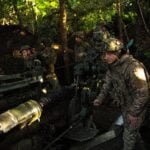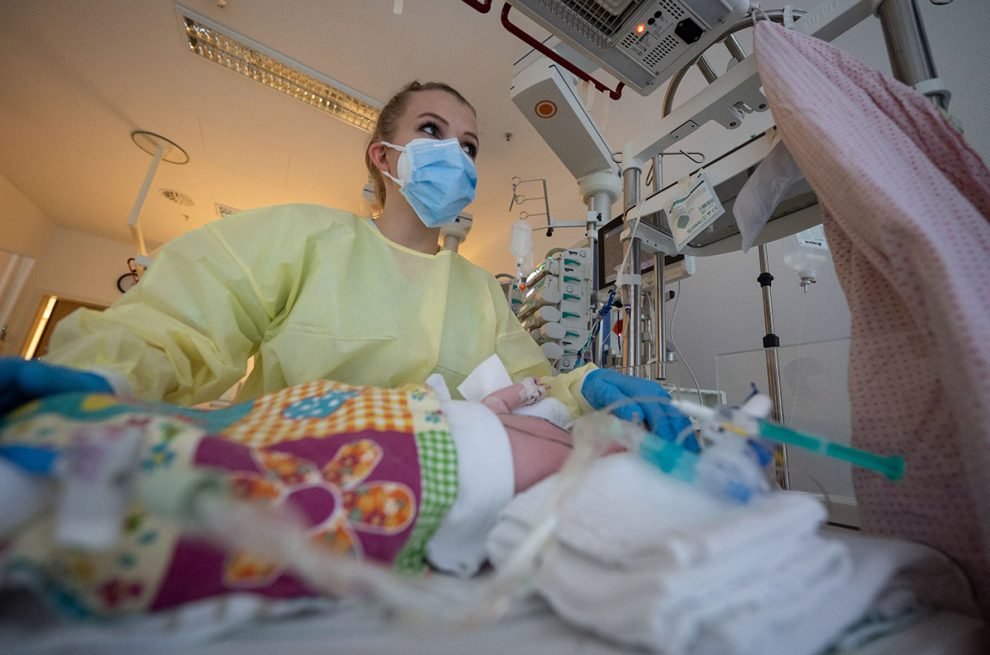As an unusually large and early seasonal surge of RSV cases inundate children’s hospitals around the country, pharmaceutical giant Pfizer offered a glimmer of hope Tuesday in the form of top-line, phase three clinical trial results.
The company’s experimental RSV vaccine—given to pregnant trial participants—was 82 percent effective at preventing severe RSV-related lower respiratory tract illness in the first three months of an infant’s life. It was 69 percent effective over the first six months, Pfizer announced.
“We are thrilled by these data as this is the first-ever investigational vaccine shown to help protect newborns against severe RSV-related respiratory illness immediately at birth,” Pfizer Chief Scientific Officer Annaliesa Anderson said in a statement.
The company said it planned to file for regulatory approval from the Food and Drug Administration by the end of the year, which may mean a vaccine could be available in time for next year’s RSV season.
The announcement is promising, but there are reasons for caution, too. The company has only released top-line results in a press release, for one thing. The data will have to go through more detailed outside review. Pfizer also noted that the vaccine failed to meet the second of the trial’s two primary goals, which was to reach the pre-determined statistical criteria for efficacy against non-severe RSV-related lower respiratory tract illness—though the company says some efficacy was clinically meaningful.
Still, there is reason to be excited by Tuesday’s news, which follows decades of struggle by researchers trying to fight RSV. That includes a disastrous vaccine trial in the 1960s, which caused vaccinated children to develop more severe disease from an RSV infection and led to the tragic death of two infants.
An oft-overlooked virus
It may seem newly famous, but RSV—or respiratory syncytial (sin-SISH-uhl) virus—is a common, seasonal virus that has long posed a grave risk to infants and toddlers. Nearly everyone is infected during childhood, and most experience only a mild respiratory illness. But for a small fraction of children, particularly those under 5, it can turn life-threatening. RSV sends around 3.6 million to the hospital each year worldwide and kills over 100,000 children under 5 each year. Deaths most often occur in infants under 6 months old and among children in lower-income countries.
In the US, RSV is among the leading causes of hospitalization for children under 5. A typical RSV season sends between 58,000 and 80,000 children under 5 to the hospital and kills between 100 to 300, the Centers for Disease Control and Prevention estimates.
Researchers have been working for decades to prevent and treat RSV. But a dark cloud loomed over the field for years, halting progress. It formed in the 1960s, when researchers began working on a vaccine against RSV. The experimental vaccine’s design used a standard treatment of the times—heat and a solution of formaldehyde (formalin) to inactivate the virus and “fix” or stabilize its proteins. Thus, the formalin-inactivated virus vaccine could present a whole virion to the immune system that was incapable of infecting cells, yet had all of its antigenic components essentially frozen in place so immune cells could learn to target key components.
Catastrophic candidate
But the vaccine was a tragic disaster. Not only did it fail to protect children from RSV in several clinical trials in 1966, but it also appeared to make the children more vulnerable to severe RSV.
For example, in one small US trial, researchers gave infants between the ages of 2 months and 7 months a three-dose regimen. Of 40 unvaccinated infants in a control group, 21 caught RSV during a subsequent wave of infection in the community, and only one of the unvaccinated children required hospitalization. Meanwhile, of 30 infants given the experimental vaccine, 20 went on to catch RSV, but 16 (80 percent) required hospitalization. Two of the children later died of bacterial pneumonia that developed after their RSV infections.
In the decades since, researchers worked out how exactly the vaccine caused “enhanced respiratory disease” (ERD) syndrome in the vaccinated children. First, the formalin-inactivated RSV vaccine spurred weak antibodies that only feebly blocked and neutralized live virus. This impotent response led to an accumulation of antibody-virus immune complexes that, in turn, activate exacerbating immune responses, including inflammation. The vaccine also spurred T cell responses that can cause exaggerated inflammation in the lung upon subsequent RSV infection. All of this can pave the way for severe disease and complications, such as bacterial pneumonia.
Shape-shifting
But researchers also had to figure out the why of the vaccine’s failure. It wasn’t until work published in the 2010s that they had complete, satisfying answers—and a way forward for safe, effective vaccines. In 2016, a leading group of vaccine researchers at the National Institutes of Health, headed by Barney Graham, published data demonstrating that it was all down to unexpected effects of the heat and formalin treatment on a key surface protein.
RSV has several important proteins on the outside surface of its viral particle. The most critical for vaccine development is the fusion glycoprotein, dubbed “F,” which is required for viral entry into human cells. The F protein is a transmembrane protein that, as it turns out, goes through a massive, irreversible shape-shift when it fuses together the RSV viral particle and a human cell membrane. It rearranges from a prefusion, or “pre-F,” conformation to a dramatically different post-fusion, or “post-F,” conformation.
Stabilized path
In the 2016 study, Graham and colleagues, including structural biologist Jason McLellan, worked out that the heat and formalin treatment to make the 1960s vaccine caused almost all of the F protein on RSV’s surface to shift from the pre-F to the post-F conformation. And this doomed the vaccine to “catastrophic failure.” The most potent neutralizing antibodies generated from RSV infection target the functional pre-F conformation. And antibodies that almost exclusively bind the post-F conformation have weak or no neutralizing activity.
Luckily, a few years before that, in 2013, Graham, McLellan and colleagues had also figured out how to lock and stabilize the F protein into its pre-F state for vaccine development. They also showed that antibodies targeting specific pre-F sites were extremely potent at neutralizing RSV. The work directly paved the way for the positive trial results announced this week from Pfizer’s vaccine, which is based on stabilized RSV prefusion F proteins.
In the company’s press release, Pfizer acknowledged the foundational basic science discoveries by the NIH researchers. “After this important discovery, Pfizer tested numerous versions of a stabilized prefusion F protein and identified a candidate that elicited a strong anti-viral immune response in pre-clinical evaluations,” the company said. “The bivalent vaccine candidate is composed of equal amounts of recombinant RSV prefusion F from subgroups A and B.”
Positive results
For their trial, Pfizer enrolled around 7,400 pregnant people, who were randomized into equal groups that received either a single vaccine dose or a placebo in the late second or third trimester. The study, which followed infants born to the participants for at least one year, found no safety concerns.
The vaccine demonstrated effectiveness against severe RSV-associated lower respiratory tract illness, which was defined for medically attended cases (seen by a doctor or hospitalized) that had at least one of the following symptoms: a respiratory rate ≥70 breaths per minute in infants younger than 2 months or ≥60 breaths per minute in those between 2 months and 12 months; blood oxygen levels <93 percent; use of oxygen delivered through a high-flow nasal cannula or mechanical ventilation; admission to an intensive care unit for more than four hours; or unresponsiveness/unconsciousness.
But, it didn’t meet the statistical criteria for non-severe medically attended lower respiratory tract illness, which was defined by indrawing of the chest wall while breathing, and by slightly lower respiratory rates and slightly higher blood oxygen levels than were used for defining severe RSV illness.
Pfizer reported that for the milder illness, the efficacy was about 57 percent in the first three months of the infant’s life and about 51 percent in the first six months, short of the statistical requirements.
Still, the maternal shot could have a big impact on a disease with no other current vaccine options. This “could substantially reduce the burden of severe RSV among newborns through six months of age,” Eric Simões, a pediatrics infectious disease specialist at University of Colorado School of Medicine and Children’s Hospital Colorado, Aurora, who worked with Pfizer on the trial. “If approved by regulatory authorities, [it] will likely have a significant impact on disease in the US. and globally.”












